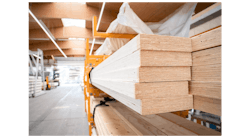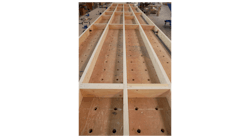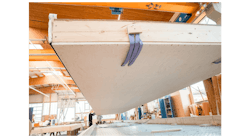A European manufacturer says its engineered wood products can store carbon for decades
Metsä Wood, a Finland-based manufacturer of engineered wood products, says its sustainable, material-efficient products can store carbon for decades, helping to combat climate change.
To build its new concrete plant of 17,000 square meters, German construction specialist Brüninghoff, which makes prefabricated wooden materials, such as laminated veneer lumber, wanted to use materials that fit its sustainability strategy. So the company chose Kerto LVL—prefabricated panels and studs made by Metsä Wood—for the plant’s exterior non-load-bearing walls. The panels were attached to load-bearing concrete frames.
Metsä Wood’s Kerto LVL, a structural laminated veneer lumber, takes up less volume than other wood materials and also has an excellent strength-to-weight ratio. In addition to supporting the sustainability strategy, Kerto LVL led to optimized assembly times.
The Brüninghoff plant has a total of 239 wall elements with an area of around 5,000 square meters. It used a total of 242 cubic meters of Kerto LVL. The team used a carbon storage calculator to determine that the Kerto LVL stores 165.8 metric tons of carbon dioxide equivalent (a unit based on global warming potential)—meaning that, compared to other construction materials, the wood in Metsä Wood’s product is “highly sustainable,” the company says.
“Through this construction, we are forcing structural change towards construction that supports circular economy. Change is needed as the construction sector is responsible for consuming huge quantities of resources. It is a question of optimizing construction methods, developing low-emission concepts, and increasingly backing recycling solutions,” Frank Steffens, managing director, Brüninghoff, said in a statement.
The building has already received pre-certification per the ecological, economic, and social criteria of the German Society for Sustainable Construction (DGNB).




